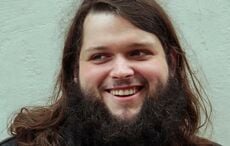A the Green Fields of America Ensemble finished the Banquet entertainment program at the recent Ireland in Dixie Weekend in Atlanta, the capacity crowd rose to their feet with spontaneous joy at the marvelous music they had just witnessed.
It was a highlight of the Comhaltas annual gathering in North America, whose mission statement proscribes the preservation and promotion of Irish traditional music.
There can be no contesting CCE importance in Ireland itself since 1951. But when it comes to preserving and promoting the music over here, the tiller of America's green fields is in the hands of one man, Dr. Mick Moloney, who arrived on these shores in 1973. Nothing has been the same since then as he elevated the profile of Irish music and those who make it.
Even with a lifetime of achievements surrounding him, watching him at work (play) over one week was truly astounding and ample evidence of why he was selected a National Heritage Award winner in 1999 as a genuine folk hero in America.
The weekend excursion to Atlanta with a 2007 version of the Green Fields of America touring group he has brought on the road since 1978 brought home to many in attendance the early role that this Limerick firebrand played in bringing Irish traditional music onto different stages.
A folk musician in Dublin with contemporaries like Paul Brady, Donal Lunny, James Keane, Christy Moore and others, academia lured him to the U.S. and Philadelphia, in particular, in 1973 to embark on graduate studies with his mentor, Dr. Kenneth Goldstein.
His studies led him to discover the vast array of older traditional musicians around America who kept the old tunes alive in ghetto-like sessions in their kitchens or small clubs more for their own amusement than for any cultural reason, though he recognized that there were children who were taking it up as well.
With the increasing attention of multicultural roots gaining ground around the time of the American Bicentennial in 1976, Moloney went into full gear to make sure that the Irish were well represented, assembling 26 outstanding older musicians for the most part to the Mall in D.C. to participate in the Smithsonian Institute Festival of American Folklife.
A few years later he would take some of them on the road (Father Charlie Coen, Jack Coen, Mike Rafferty, Billy McComiskey, Brendan Mulvihill, Liz Carroll, Donny Golden and Michael Flatley) in the first Green Fields of America tours around the country to bring Irish music to venues where it hadn't been seen before on performance stages.
For almost three decades now through that vehicle and others he has liberated trad music from the obscurity of the kitchen session and placed it in the spotlight for all to see and enjoy. So when the Atlanta crowd applause for the music of Moloney, Jerry O'Sullivan, Billy McComiskey, Joanie Madden, Athena O'Lochlann Tergis, Robbie O'Connell, Father Charlie Coen, Mike Rafferty and James Keane filled the room, the pride also was palpable.
Awaiting Moloney's return from Atlanta much delayed thanks to the unseasonable Nor'easter attacking the East Coast were two days of organizing and rehearsing for a TV taping for a potential show for the PBS network next March. It was under the auspices of a New York State Music Fund Grant of $100,000 given to the Irish Arts Center and Moloney to produce the show, Mick turned to another stable of performers whose professional careers he has encouraged over the decades that thankfully now can make a living at the music.
On Wednesday over 200 people were privileged to see two performances of a truly all-star cast made all the better because of the cumulative talent on hand and their familiarity with one another down through the years as well. It was comprised of young veterans like John Doyle, Seamus Egan, Joanie Madden, Eileen Ivers, Karan Casey, Brendan Dolan, Athena O'Loghlann Tergis, Timmy Collins, Susan McKeon and slightly older ones like Billy McComiskey, Robbie O'Connell and Liz Carroll, all who along with Moloney performed
with senior like Mike Rafferty and Josephine MacNamara. Dancers Niall O'Leary and Darragh Carr rounded out the troupe for the TV taping.
It was truly an historic gathering at the Irish Arts Center which thankfully will be available to the general PBS audience in the future.
Finally last Saturday, the academician Moloney held the crowd in the Proshansky Auditorium in rapt attention at the final plenary address at the American Conference of Irish Studies hosted by City University of New York.
His presentation of "Edward Harrigan and the Beginning of American Musical Theater" enlightened folks about the early entertainment work performed in the 19th century when Irish emigrants were emerging as a primary force in the development of this country.
His research resulted in a critically acclaimed CD release last year called McNally's Row of Flats with a detailed companion booklet that provides so much information about a seminal Irish American who produced much more than the ditty H-A-R-R-I-G-A-N that we are all familiar with, though out of historical context.
Following on his equally informative CD and book Far From the Shamrock Shore released in 2002, Moloney has not only breathed new life into his own career at New York University and on stage but also found a way to make lifelong learning entertaining for the rest of us, even some of us who thought we knew what we were talking or writing about in Irish music.
Also it is becoming increasingly clear that much of the fertile ground for Irish music is happening on campus these days rather than the commercial scene so Moloney's influence there is very important as well. It's a job to keep up with him, but the journey is well worth making.




Comments